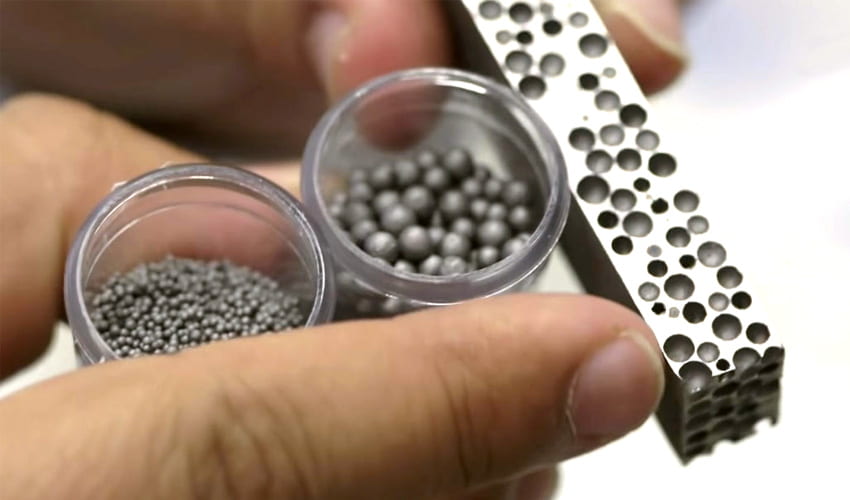
NYU Tandon Researchers Pioneer Printing Syntactic Foam on Commercial 3D Printers
By Joe Wread
How would you like to 3D print your own mini-sub and explore the deep sea? Or maybe you want to 3D print new parts for your car to make it lighter, faster, and more fuel efficient. Thanks to research being conducted by Nikhil Gupta, an associate professor of mechanical and aerospace engineering at the NYU Tandon School of Engineering, these ideas are getting closer to reality — and not with futuristic materials, but with ones that have been around for decades.
In 1955, researchers at the Bakelite Company created a material they named “syntactic foam,” a stiff plastic containing extremely small, hollow components called “microspheres” or “microballoons.” These tiny structures made the material in which they were embedded strong, light, and temperature-resistant, enabling syntactic foam to replace heavier materials in the manufacturing of goods. With roots in the aerospace and deep-sea industries, syntactic foams are also used in the construction, energy production, automobile, and sports equipment industries. These innovations have allowed us to travel to the deepest parts of the ocean (as James Cameron did with his Deepsea Challenger in 2012, descending to a depth of over six miles and 16,000 psi), helped make the aerospace industry safer, and made generating energy more efficient.

For decades, and often still today, syntactic foam was created using an injection moulding process by which the foam is fabricated into specific shapes. It is then typically sandwiched or layered with a face sheet material. While this method is able to produce countless shapes, the final results are limited in size and complexity. This forces some products to be created in pieces and then assembled using adhesives and fasteners, creating weakened or inconsistent structural integrity. With 3D printing, however, those limitations have begun to be removed. Gupta and his team at NYU Tandon hope to leverage 3D printing to create syntactic foam with much greater affordability than in the past and without the need for highly-specialized 3D printing equipment. To accomplish this, they needed to create a new filament compatible with commercial 3D printers.
3D printing makes it possible to create entire designs at once, removing the need to connect pieces together. It offers a significant increase in both complexity and strength compared to what was attainable before. Gupta and Tandon’s Composite Material and Mechanics Lab, along with collaborators in India, have successfully used polyethylene and polypropylene plastic as the matrix material for their recently-developed syntactic foam 3D printer filament. During development of both the filament and the foam, the team faced several challenges, including microspheres fracturing while making and printing with the filament, clogging of the extruder nozzle, and ensuring proper microsphere distribution within the filament and final print. By mixing polyethylene plastic (HDPE) and microspheres created from fly ash (a coal combustion product), they have created the first syntactic foam-printing filament that is compatible with an off-the-shelf 3D printer.
Gupta explained, “In our work, we have mostly used commercially-available hollow glass particles of about 40 microns in average diameter. Such a small diameter is necessary to make sure that the extruder nozzle is not clogged by the particles during [the] filament extrusion and 3D printing process. We developed an extruder design that was capable of providing [a] high-quality filament without breaking particles in substantial numbers. A patent application was filed through NYU for the extruder design. Our focus for this project was to develop a filament that can be used with commercial 3D printers without any hardware modifications.”
During their research, they found the .04mm microspheres and 1.7mm nozzle resulted in the least amount of crushing of the embedded spheres and the fewest clogs when compared to other combinations they tested. The mixture results in about 40% by weight of microspheres to HDPE. However, even though these microspheres make stronger and lighter materials, they are still quite fragile. Using smaller microspheres, rather than larger ones, helped the team avoid the problem of crushing them during the mixing phase.

The team also had to contend with precise requirements for the printing environment. “The printing needs to be conducted on a plate that has coefficient of thermal expansion matched with the filament material so that warping of the 3D-printed structure during cooling can be minimized,” explained Gupta. “The extrusion temperature and speed are also optimized for the syntactic foam composition. Most 3D printers allow changing settings of printing conditions such as temperature and print head movement speed, so these are not limiting factors.”
In addition to the typical recipe, nanofillers such as carbon nanotubes and air bubbles are being tested in order to further improve the filament properties. Gupta and his collaborators are also working with several variations of microspheres to improve density, strength, and durability. In the future, they aim to develop microspheres from a wide array of materials—metal, new alloys, polymers, and ceramics—while being able to adjust their size, wall-thickness, contents and coatings. Visit engineering.nyu.edu/composites/ to learn more and to follow their progress.
Additional Sources
- “Engineering the Strongest Foam in the World” (Motherboard)
- “3-D Printing Breakthrough for Lightweight Syntactic Foams Could Help Submarines Dive Deeper” (NYU Tandon Press Release)
- “What is Syntactic Foam?” (Engineered Syntactic Systems)